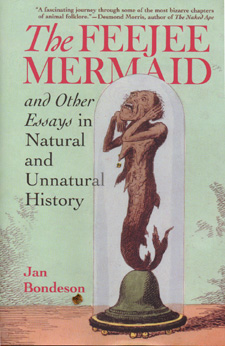 |
|
The Feejee Mermaid and Other Essays in Natural and Unnatural History Bondeson, Jan, Ithaca: Cornell University Press, 1999. Pp. xi, 315. $29.95. Reviewed by Justin Nordstrom, Indiana University In The Feejee Mermaid, physician Jan Bondeson presents a collection of essays that aim to explore some of the most prominent examples of the supernatural in modern Western culture. Bondeson explains that the anthology is the product of his long interest in exploring archaic subjects as a ìrecreationî from his medical studies. Indeed, his book makes for extremely interesting reading, presenting a wide-range of exotic storiesfrom subterranean toads encased in stone to dancing horses and performing pigs. But Bondeson's work is more than a series of colorful anecdotes. Instead, Bondeson's analytical yet non-reductionistic approach to the supernatural provides a model for other writers intent on exploring phenomena that have been marginalized by more conventional social or scientific inquiries. Bondeson's essays are most helpful in detailing the supernatural's cultural influence and importance in Western societies where paranormal events have generated tremendous notoriety and controversy throughout the modern era. In fact, in some ways, it seems unusual to review The Feejee Mermaid in a journal dedicated to esotericism. The mermaids, circus elephants, magical lambs, and petrifying lizards that populate Bondeson's anthology were anything but secretive entities. Instead, as Bondeson points out, they were public spectacles, whether as moneymaking attractions or objects of a community's fear and dread. Nonetheless, this text would prove quite useful for scholars interested in exploring the cultural, linguistic, mythic, literary or religious dimensions of supernatural beliefwhether public or secret. Bondeson draws on a wide variety of sources, including pamphlets, music, poetry, plays, novels, and sacred scriptures to illustrate the origins and development of supernatural legends. By compiling these materials, Bondeson seeks to shed light on paranormal stories of fantastic lizards, spontaneously generated fowl or super-intelligent livestock without explaining away their social contributions in favor of rationalist approaches. Furthermore, Bondeson draws on his own medical background to illustrate how contemporary theories of micro and viral biology reflect earlier notions of spontaneous generation, now generally labeled absurd or outdated. One of the book's most ambitious and successful goals, then, is to complicate "The verdict of the traditionalist, positivist historiography of science" (p. 248). |
||
|
|
||
| Although careful attention
to the supernatural's cultural importance is a central component of
Bondeson's analysis, it also presents contradictions and limitations
in his work. Bondeson often suggests that fascination with paranormal
creatures and events was linked to specific social and historical
developments, particularly Europe's contact with "exotic"
locations, the middle class's growing prevalence and affluence in
the early modern era and the transformation of England's religious
and ideological climate. Elsewhere, however, Bondeson indicates that
interest in various supernatural legends is simply a universal aspect
of the human imagination which has existed throughout history and,
he writes, " . . has fascinated humankind since the beginning
of time" (p. 251). Bondeson's anthology thus presents a conundrum:
are the events that he describes the result of particular social,
cultural and historical circumstances, or are they universal and,
therefore, unchanged over time. Bondeson's essays do not provide a
convincing answer either way. While his essays leave room for the
possibility that interest in the supernatural can be shaped by both
socio-cultural environments as well as humanity's universal imagination,
this concept is never fully developed or articulated.
Another limitation of this anthology is that it ends without a clear attempt to synthesize these stories or draw conclusions about early-modern rationalism or contemporary historiography. In general, Bondeson seems far less interested in engaging historical dialogue than in captivating and tantalizing the reader. Overall, The Feejee Mermaid will be likely prove more important to scholars for its presentation of previously under-explored material than for advancing or informing academic debate. |